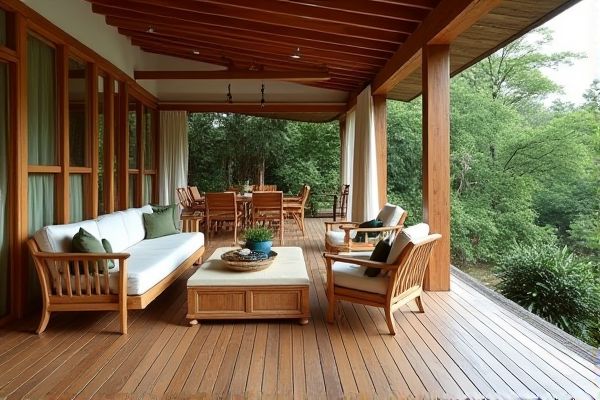
Polywood furniture offers superior weather resistance and low maintenance, making it ideal for terraces exposed to varying outdoor conditions, while hardwood furniture provides natural beauty and durability but requires regular upkeep to prevent damage. Discover the best choice for your terrace by exploring the detailed comparison in the rest of this article.
Table of Comparison
| Feature | Polywood Furniture | Hardwood Furniture (Terrace) |
|---|---|---|
| Material Composition | Recycled HDPE plastic, synthetic wood | Natural wood (teak, oak, mahogany, eucalyptus) |
| Durability | Highly weather-resistant, moisture-proof, resists fading and cracking | Durable but prone to weather damage, requires maintenance to prevent rot |
| Maintenance | Low maintenance: easy cleaning with soap and water | High maintenance: regular sealing, staining, or oiling needed |
| Environmental Impact | Eco-friendly: made from recycled materials, recyclable | Depends on wood sourcing; sustainably harvested options available |
| Appearance | Consistent color and texture, mimics wood grain | Natural wood grain and unique texture, ages with patina |
| Weight | Heavier than wood due to density | Generally lighter, easier to move |
| Price | Moderate to high, long-term cost-effective | Varies; premium hardwoods can be expensive |
| Resistance to Pests | Resistant to insects and termites | Vulnerable to insect damage without treatment |
| Ideal Use | Outdoor terrace furniture requiring durability and low upkeep | Outdoor terrace furniture with natural aesthetic, regular care |
Introduction to Polywood and Hardwood Terrace Furniture
Polywood terrace furniture is made from recycled plastic lumber, offering resistance to weather, moisture, and insects, making it an ideal low-maintenance option for outdoor settings. Hardwood terrace furniture, typically crafted from teak, eucalyptus, or acacia, provides natural durability, a rich aesthetic, and long-lasting strength, but requires regular care to prevent weathering. Choosing between Polywood and hardwood furniture depends on your preference for sustainability, maintenance level, and the desired natural look on your terrace.
Material Composition: Polywood vs Hardwood
Polywood furniture is made from high-density polyethylene (HDPE) recycled plastics, which offers resistance to moisture, insects, and UV damage, making it ideal for outdoor terrace use. Hardwood furniture, crafted from natural timber like teak, oak, or mahogany, provides exceptional strength and natural beauty but requires regular maintenance to prevent weathering and decay. Your choice between polywood and hardwood depends on whether you prioritize low maintenance and durability or natural aesthetics and traditional craftsmanship for your terrace furniture.
Durability and Weather Resistance
Polywood furniture offers superior weather resistance due to its synthetic composition, making it highly durable against moisture, UV rays, and temperature fluctuations on terraces. Hardwood furniture, such as teak or cedar, provides natural strength and can last long with proper maintenance but is more susceptible to weather-induced wear like cracking and fading. For terrace use, Polywood's low maintenance and resistance to mold and rot often make it a more durable choice compared to traditional hardwood options.
Maintenance Requirements
Polywood furniture requires minimal maintenance, needing only occasional cleaning with soap and water to resist fading, cracking, and moisture damage. Hardwood furniture for terraces demands regular sealing or staining to protect against weather elements, preventing rot and insect infestation. Choosing Polywood reduces upkeep time and costs compared to the ongoing treatments necessary for hardwood durability.
Aesthetic Appeal and Style Options
Polywood furniture offers a modern, versatile aesthetic with a wide range of color options that resist fading and weathering, making it ideal for vibrant terrace designs. Hardwood furniture provides a classic, natural beauty with unique grain patterns and rich tones, appealing to those who prefer timeless elegance in their outdoor space. Your choice depends on whether you prioritize customizable styles or the authentic warmth and texture of natural wood.
Cost Comparison: Polywood vs Hardwood
Polywood furniture typically offers a more affordable option compared to hardwood furniture, with initial costs generally 20-40% lower depending on the wood species and craftsmanship involved. Hardwood furniture, made from solid timber like teak or oak, commands higher prices due to raw material costs and durability. You can expect polywood to provide cost savings both upfront and in maintenance, as it resists weathering and requires less frequent refinishing than hardwood terrace furniture.
Environmental Impact and Sustainability
Polywood furniture, made from recycled plastic lumber, offers significant environmental benefits by repurposing waste materials and reducing deforestation compared to traditional hardwood furniture. Hardwood furniture, sourced from natural trees, involves logging practices that can contribute to habitat destruction and carbon emissions unless certified by sustainable forestry programs like FSC. Choosing Polywood supports long-lasting durability with minimal maintenance while conserving natural forests, making it a more sustainable option for terrace furniture.
Comfort and Ergonomics
Polywood furniture offers enhanced comfort with its smooth, weather-resistant surface that adapts well to outdoor conditions without warping or splintering, making it ideal for terrace use. Hardwood furniture provides natural ergonomic support with its sturdy structure and contouring that molds to body shapes over time, delivering lasting comfort. Both materials prioritize user comfort, but Polywood excels in low maintenance and consistent ergonomics in varying climates.
Installation and Assembly Differences
Polywood furniture typically features lightweight components and simple assembly requiring minimal tools, making installation on your terrace quick and user-friendly. Hardwood furniture often involves heavier pieces and complex joints, necessitating professional installation or more time and effort for DIY assembly. The ease of setup for Polywood enhances convenience, especially in outdoor settings where frequent rearrangement or seasonal storage might be needed.
Choosing the Best Terrace Furniture for Your Needs
Polywood furniture offers exceptional durability, weather resistance, and low maintenance, making it ideal for terraces exposed to varying outdoor conditions. Hardwood furniture, such as teak or eucalyptus, provides natural beauty and strength but requires regular upkeep to prevent damage from moisture and UV rays. Your choice depends on whether you prioritize long-lasting convenience or the classic aesthetic of natural wood for your terrace.
 homyna.com
homyna.com